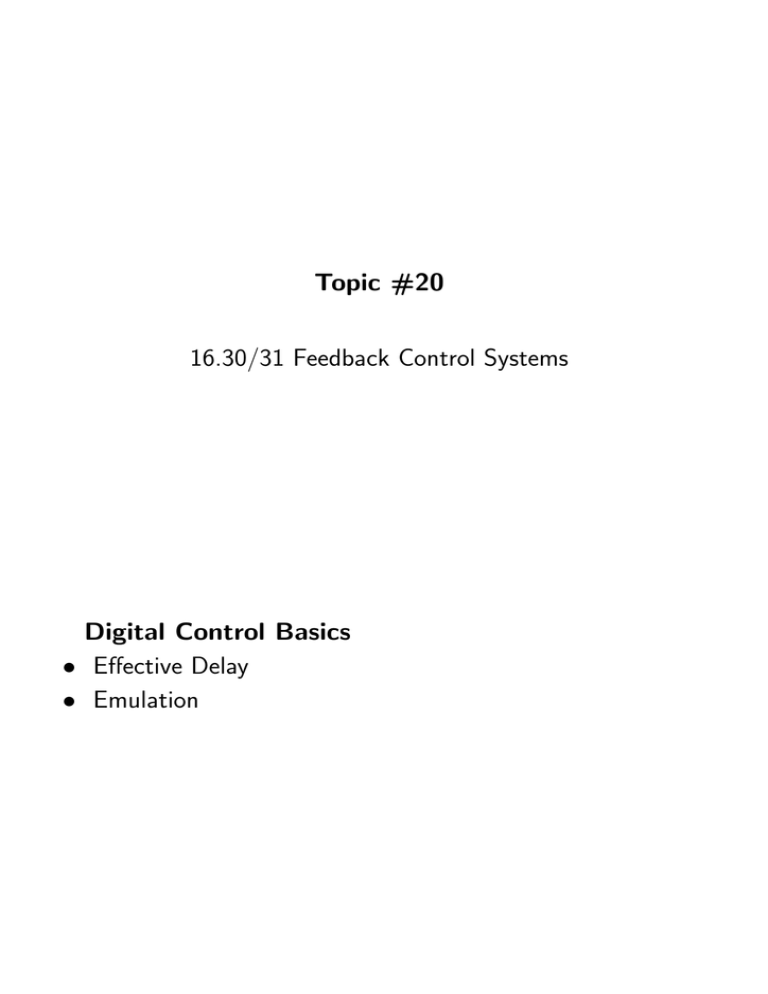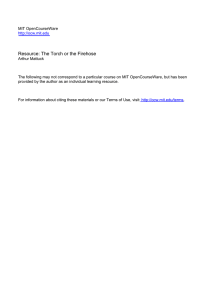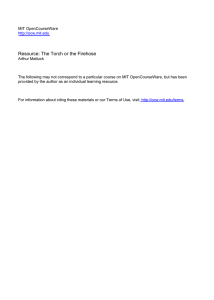Topic #20 16.30/31 Feedback Control Systems Digital Control Basics
advertisement

Topic #20 16.30/31 Feedback Control Systems Digital Control Basics • Effective Delay • Emulation Fall 2010 16.30/31 20–1 Digital Control • Control picture so far d r e Gc(s) − u Gp(s) y • Can implement this using analog circuits, but as you have seen, there are many advantages to implementing these using a computer – much more flexible • In this case the new picture is: r(t) ek A2D Gc(s) uk u(t) D2A − yk Digital Computer November 5, 2010 A2D Gp(s) y(t) Fall 2010 16.30/31 20–2 Digital Control Mechanics • Digital/discrete control runs on a clock • Only uses the input signals at discrete instants in time • So continuous e(t) is sampled at fixed periods in time e(kTs) • Where Ts is the sampling period and k is an integer • Must also get information into and out of the computer • Requires A/D and D/A operations • The A/D consists of 2 steps: 1. Convert a physical signal (voltage) to a binary number, which is an approximation since we will only have a 12-16 bits to cover a ±10V range. 2. Sample a continuous signal e(t) every Ts seconds so that y(t) ⇒ y(k) Ts y(t) y(k) Image by MIT OpenCourseWare. 3. Sampler clearly ignores a large part of the continuous signal. November 5, 2010 Fall 2010 16.30/31 20–3 • The D/A consists of 2 steps as well 1. Binary to analog 2. Convert discrete signal (at kTs) to a continuous one. u(k) u(t) k=1 ? Easiest way is to just hold u(k) for period Ts 1 2 3 4 5 6 7 Image by MIT OpenCourseWare. • Basic approach is to just hold the latest value of u(k) for the entire periods Ts • Called a zero-order hold (ZOH) • Need to determine what impact this “sample and hold” operation might have on the loop transfer function • Approximate the A/D as sample • Approximate D/A as ZOH • Set control law to 1, so u(k) = e(k) y(t) A/D CONTROL Ts y(t) u(k) = y(k) D/A ZOH u(t) u(t) Image by MIT OpenCourseWare. November 5, 2010 Fall 2010 16.30/31 20–4 Sample and Hold Analysis • Can actually analyze the transfer function U (s)/E(e) analytically • Can also gain some insight by looking at basic signals • u(k) has a standard box car shape • Smoothed u(k) by connecting mid-points ⇒ û(t) • So sampled and held e(t) looks like input e(t), but delay is obvious. • Analytic study of U (s)/E(e) shows that effective delay of sample and hold is Ts/2 on average • Can be a problem if Ts is too large November 5, 2010 Fall 2010 16.30/31 20–5 • So why not just make Ts small? • Key point is that Ts is how long we have to compute the control command given the measurements received Read: y Wait Calc #2 Calc #1 Write: u Read: y Time Image by MIT OpenCourseWare. • Usually wait period is short, but length of calc 1 and calc 2, A/D and D/A operations depend on the complexity of the algorithm and the quality of the equipment • But quality ↑ ⇒ cost ↑↑ • Typically would set sampling frequency ω2 = November 5, 2010 2π Ts ≈ 15ωBW Fall 2010 16.30/31 20–6 Control Law • Basic compensator Gc(s) = Kc s + z U (s) = s + p E(s) • Equivalent differential equation form u̇ + pu = Kc(ė + ze) • Differential equation form not useful for a computer implementation - need to approximate the differentials 1 uk+1 − uk u̇|t=kTs ≈ [u((k + 1)Ts) − u(kTs)] ≡ Ts Ts • This uses the forward approximation, but others exist • Then u̇ + pu = Kc(ė + ze) approximately becomes uk+1 − uk ek+1 − ek + puk = Kc( + zek ) Ts Ts or uk+1 = (1 − pTs)uk + Kcek+1 − Kc(1 − zTs)ek which is a recursive difference equation, that can easily be imple­ mented on a computer. • Similar case for state space controllers ẋc = Acxc + Bce u = Ccxc + Dce and ẋc ≈ xc (k+1)−xc (k) Ts so that xc(k + 1) − xc(k) = Acxc + Bce Ts xc(k + 1) = (I + TsAc)xc(k) + TsBce(k) u(k) = Ccxc(k) + Dce(k) November 5, 2010 Fall 2010 16.30/31 20–7 Computer Code Layout • Given previous information uk and ek and new information yk+1 and rk+1, form ek+1 • Need to use the difference equation to find uk+1 uk+1 = (1 − pTs)uk + Kcek+1 − Kc(1 − zTs)ek • Then let uold = (1 − pTs)uk − Kc(1 − zTs)ek , so that uk+1 = Kcek+1 + uold • Also define constants γ1 = (1 − pTs) and γ2 = −Kc(1 − zTs) • Then the code layout is as follows: initialize uold while k < 1000 do k = k + 1 sample A/D’s (read yk+1, rk+1) compute ek+1 = rk+1 − yk+1 update uk+1 = Kcek+1 + uold output to D/A (write uk+1) update uold = γ1uk+1 + γ2ek+1 wait end while • Note that this outputs the control as soon after the data read as possible to reduce the delay • result is that the write time might be unknown • Could write uk+1 at end of wait – delay is longer, but fixed November 5, 2010 Fall 2010 16.30/31 20–8 Summary • Using a digital computer introduces some extra delay • Sample and hold ≈ Ts/2 delay • Holding u(k) to end of loop ≈ Ts delay • So the delay is ≈ Ts/2–3Ts/2 • Emulation process – design the continuous control accounting for an extra ωcTs 180◦ ωc2π 180◦ ωc ◦ · = · = 180 2 π 2ωs π ωs to the PM to account for the delay. • With ωs ≈ 15ωBW , delay effects are small, and the cts and discrete controllers are similar • c2dm.m provides simple ways to discretize the continuous controllers • Lots of different conversion approaches depending on what proper­ ties of the continuous controller you want to preserve. November 5, 2010 MIT OpenCourseWare http://ocw.mit.edu 16.30 / 16.31 Feedback Control Systems Fall 2010 For information about citing these materials or our Terms of Use, visit: http://ocw.mit.edu/terms.






